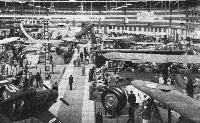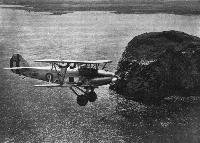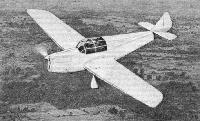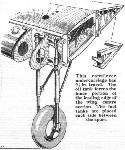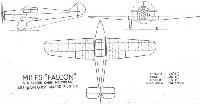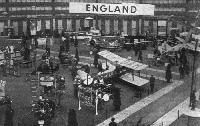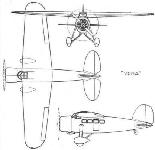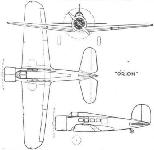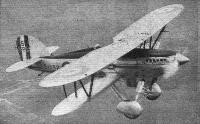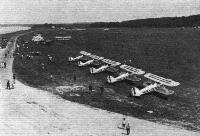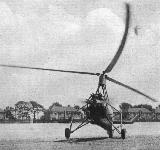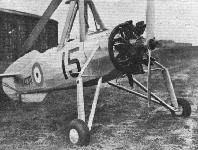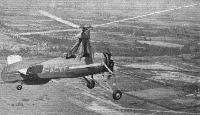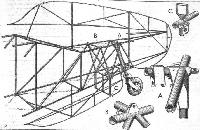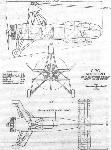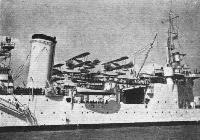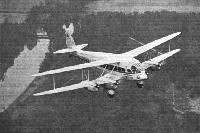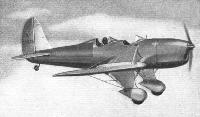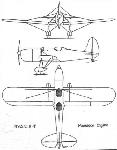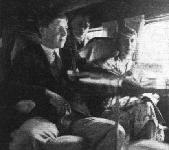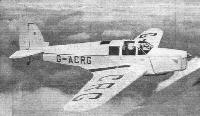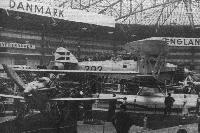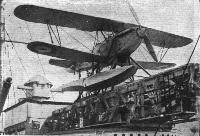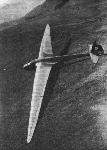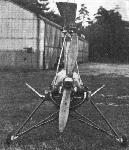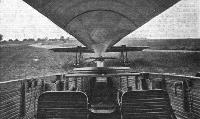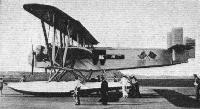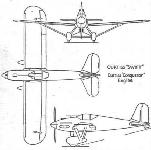Фотографии
-
A general view from the opposite end of the Forum hall, with the Caudron monoplane on the left, the Russian machine on the right, and the Danish-built Hawker "Dantorp" beyond. Suspended from the roof is the Danish glider.
Самолёты на фотографии: Caudron C.430 Rafale - Франция - 1934Hawker Horsley / Dantorp - Великобритания - 1925Поликарпов Р-5 - Россия - 1928
-
Самолёты на фотографии: Туполев АНТ-20 Максим Горький - Россия - 1934
-
Регистрационный номер: K3859 GREAT STUFF! The Bass Rock in the Firth of Forth, the home of the Solan goose or gannet, is a familiar sight to visitors to the popular resort of North Berwick. This photograph shows one of the "Harts" ("Kestrel") of No. 603 (City of Edinburgh) (Bomber) Squadron flying past the Bass Rock.
Самолёты на фотографии: Hawker Hart - Великобритания - 1928
-
Самолёты на фотографии: Miles Falcon M.3 / Hawcon M.6 - Великобритания - 1934
-
This cantilever undercarriage has 9 1/2 in. travel. The oil tank forms the inner portion of the leading edge of the wing centre section. The fuel tanks are placed each side between the spars
Самолёты на фотографии: Miles Falcon M.3 / Hawcon M.6 - Великобритания - 1934
-
Miles "Falcon" 3-4 Seater Cabin Monoplane 130 h.p. D.H. Gipsy Major Engine
Самолёты на фотографии: Miles Falcon M.3 / Hawcon M.6 - Великобритания - 1934
-
READY FOR THE FRAY: A "Bulldog" of No. 17 (Fighter) Squadron waiting at Kenley to go up on night patrol.
Самолёты на фотографии: Bristol Bulldog - Великобритания - 1927
-
Регистрационный номер: URSS-2239 SOVIET MISSION TO PARIS: Two of the A.N.T.14 machines, which flew from Russia to Paris, at Le Bourget.
Самолёты на фотографии: Туполев ТБ-3Р - Россия - 1932
-
A PURSUIT TYPE: The Boeing P-26. The engine is a Pratt and Whitney "Wasp" of about 600 h.p.
Самолёты на фотографии: Boeing P-26 Peashooter - США - 1932
-
Boeing Pratt & Whitley 600 hp. "Wasp" Engine
Самолёты на фотографии: Boeing P-26 Peashooter - США - 1932
-
PITCH: A Fairey metal airscrew from the Schneider Trophy Supermarine S.6 will be shown at Copenhagen.
Самолёты на фотографии: Supermarine S.5 / S.6 - Великобритания - 1927
-
Регистрационный номер: OY-DAH ON THE S.B.A.C. STAND: Bristol and Rolls-Royce engines in the foreground, with the de Havilland "Moth Major" behind them. Farther back can be seen the Armstrong-Whitworth "Scimitar," and on the right the Avro built Autogiro.
Самолёты на фотографии: Armstrong Whitworth Scimitar / A.W.16 / A.W.35 - Великобритания - 1931Cierva/Avro C.30A / Rota - Великобритания - 1932De Havilland Moth Major / D.H.60GIII - Великобритания - 1932
-
FOR RECONNAISSANCE: The Mureaux 113.R2 (Hispano-Suiza 12 Ybrs engine) high-wing monoplane. It can also be used for light bombing.
Самолёты на фотографии: ANF Mureaux Mureaux 113/115/117 - Франция - 1933
-
"Mureaux" 113 R2 Hispano Suiza 12 Ybrs Engine
Самолёты на фотографии: ANF Mureaux Mureaux 113/115/117 - Франция - 1933
-
Регистрационный номер: NC57V A SIX-SEATER: The Bellanca "Senior Skyrocket" cabin monoplane.
Самолёты на фотографии: Bellanca Pacemaker / Skyrocket - США - 1928
-
Bellanca "Senior Skyrocket"
Самолёты на фотографии: Bellanca Pacemaker / Skyrocket - США - 1928
-
The "Vega" (" Wasp" SC1)
Самолёты на фотографии: Lockheed Vega - США - 1927
-
The "Vega" (" Wasp" SC1)
Самолёты на фотографии: Lockheed Vega - США - 1927
-
Регистрационный номер: NC13747 "Orion" ("Wasp" S1D1).
Самолёты на фотографии: Lockheed Orion 9 - США - 1931
-
"Orion" ("Wasp" S1D1).
Самолёты на фотографии: Lockheed Orion 9 - США - 1931
-
Регистрационный номер: S1592 A SINGLE-SEATER FIGHTER: The Fairey "Firefly" (Rolls-Royce "Kestrel").
Самолёты на фотографии: Fairey Firefly - Великобритания - 1925
-
FURIES IN CANADA: A line of aircraft which took part In the demonstration at Ottawa in July.
Самолёты на фотографии: Hawker Fury - Великобритания - 1931
-
The Martin B-10. It has two Wright "Cyclones" of 650 h.p. each.
Самолёты на фотографии: Martin B-10 / Type 139 / 166 - США - 1932
-
"SITTING DOWN": The latest type of Autogiro (7-cyl. Siddeley "Genet Major") touches down with its tail wheel first when coming down steeply.
Самолёты на фотографии: Cierva/Avro C.30A / Rota - Великобритания - 1932
-
Самолёты на фотографии: Cierva/Avro C.30A / Rota - Великобритания - 1932
-
Регистрационный номер: K4230 [2] FOR "STAFF" TRANSPORT. The first of the Avro C.30a Autogiros ready for delivery to the Royal Air Force for Array co-operation work. Note the upper identification mark painted on the top of the fuselage.
Самолёты на фотографии: Cierva/Avro C.30A / Rota - Великобритания - 1932
-
Регистрационный номер: K4230 [2] TO TAKE LANDING SHOCKS. Autogiros can land vertically, hence this wide undercarriage with compression legs having a long travel to take up the shock. The engine is a 140 h.p. 7-cyl. Siddeley "Genet Major."
Самолёты на фотографии: Cierva/Avro C.30A / Rota - Великобритания - 1932
-
Регистрационный номер: G-ACWF UNSTALLABLE: The Cierva "Autogiro" built by A. V. Roe & Co., Ltd., will be exhibited at Copenhagen, and another machine will be available at the aerodrome. The engine is a 7-cyl. Siddeley "Genet Major."
Самолёты на фотографии: Cierva/Avro C.30A / Rota - Великобритания - 1932
-
IN THE COCKPIT: The flying controls are confined to a single "hanging" stick, the foot bar being used for operating the tail wheel when the machine is taxying.
Самолёты на фотографии: Cierva/Avro C.30A / Rota - Великобритания - 1932
-
Самолёты на фотографии: Cierva/Avro C.30A / Rota - Великобритания - 1932
-
WELDED CONSTRUCTION. The rear of the fuselage with the tail-wheel mounting.
Самолёты на фотографии: Cierva/Avro C.30A / Rota - Великобритания - 1932
-
FUSELAGE DETAILS. The letters show the position of the enlarged details on the fuselage.
Самолёты на фотографии: Cierva/Avro C.30A / Rota - Великобритания - 1932
-
FOR A SMALL HANGAR. Two of the blades may be folded on their hinges to enable the machine to be housed in a small space.
Самолёты на фотографии: Cierva/Avro C.30A / Rota - Великобритания - 1932
-
DIRECT CONTROL: The way in which the rotor head is tilted should be clear from these diagrammatic views.
Самолёты на фотографии: Cierva/Avro C.30A / Rota - Великобритания - 1932
-
C.30 Autogiro 140 hp. Armstrong Siddeley Genet Major Engine
Самолёты на фотографии: Cierva/Avro C.30A / Rota - Великобритания - 1932
-
WITH "PEGASUS" ENGINE: The Anbo IV two-seater military monoplane. This photograph was taken during a recent visit to Croydon.
Самолёты на фотографии: ANBO ANBO IV / ANBO 41 - Литва - 1932
-
BUSINESSLIKE: Showing the installation of the Bristol "Pegasus" engine in the Anbo IV and the wide undercarriage.
Самолёты на фотографии: ANBO ANBO IV / ANBO 41 - Литва - 1932
-
THE DANISH ARMY AIR FORCE STAND: The machine in the foreground is a Danish Fokker with Bristol "Pegasus" engine. Beyond it, on the left, can just be seen the de Havilland "Tiger Moth."
Самолёты на фотографии: De Havilland Tiger Moth / D.H.82 - Великобритания - 1931Fokker C.V / C.VI - Нидерланды - 1924
-
IN ENGLAND NOW: The 10,000-ton U.S. cruiser Minneapolis arrived at Gravesend last Friday for a ten days' visit. Here are her four Vought "Corsair" seaplanes. Compare this photograph with that of the catapult on H.M.S- Sussex, which is going to the Melbourne celebrations.
Самолёты на фотографии: Vought O2U/O3U/V-65/V-93 Corsair - США - 1926
-
Регистрационный номер: K4295 THE BLACKBURN T.S.R.: The letters stand for torpedo, spotting, reconnaissance and the engine is a Siddeley "Tiger."
Самолёты на фотографии: Blackburn Shark / B-6 - Великобритания - 1933
-
Регистрационный номер: K4190 The Fairey Torpedo Spotter reconnaissance ship-plane (Bristol "Pegasus"). An order will probably be placed shortly for machines of this type to equip a squadron of the Fleet Air Arm.
Самолёты на фотографии: Fairey Swordfish - Великобритания - 1934
-
NOT AN ACCIDENT: The Avro 626 is variously used for training in gunnery, bombing, photography and wireless.
Самолёты на фотографии: Avro Tutor/Sea Tutor/Prefect / Type 621/646/626 - Великобритания - 1929
-
Регистрационный номер: G-ACVY CRUISING AT 145 M.P.H.: One of the D.H.86's which are being used on Railway Air Services' Glasgow run, photographed near Hatfield. The "Diana" class is probably the fastest four-engined commercial machine in the world.
Самолёты на фотографии: De Havilland Express Air Liner / D.H.86 - Великобритания - 1934
-
FOR THE ROYAL AIR FORCE: The Fairey night bomber (2 Rolls-Royce "Kestrels") is now in production and will be the first monoplane, apart from amphibian flying boats, to be issued to the R.A.F. The machine as here seen was being piloted by Flt. Lt. C. Staniland, Fairey's chief test pilot.
Самолёты на фотографии: Fairey Hendon - Великобритания - 1930
-
A FRENCH FEEDER LINE MACHINE: The new Potez 56 has a retractable undercarriage, and its two Potez radial engines are supercharged. Six passengers are carried. Its resemblance to the Airspeed "Envoy" is quite marked.
Самолёты на фотографии: Potez Potez 56 - Франция - 1934
-
Регистрационный номер: NC12564 Showing interest in the Beechcraft at Reading.
Самолёты на фотографии: Beechcraft Model 17 Staggerwing - США - 1932
-
Регистрационный номер: NC12584 HIGH SPEED COMFORT. The new Beechcraft in which Mr. W. Faust, Director of Aviation Sales, and Mr. H. White, Aviation Sales Manager, of the Socony-Vacuum Oil Co., Inc., will shortly be touring Europe. With a retractable undercarriage this four-seater has a top speed of 170 m.p.h. It has a 225 h.p. Jacobs engine. Flaps reduce the landing speed to 45 m.p.h.
Самолёты на фотографии: Beechcraft Model 17 Staggerwing - США - 1932
-
Регистрационный номер: X14223 95 H.P. - 145 M.P.H. The Ryan S-T two-seater with Menasco B.4 engine of 95 h.p.
Самолёты на фотографии: Ryan ST / PT-22 Recruit - США - 1934
-
Ryan S-T Menasco Engine
Самолёты на фотографии: Ryan ST / PT-22 Recruit - США - 1934
-
Регистрационный номер: NC822M BRAZILIAN CLIPPER TAKES OFF: Pan-American Airways' first Sikorsky S-42 leaves Biscayne Bay for Buenos Ayres. It is reported that Short Bros, are building a large trans-oceanic boat for Imperial Airways.
Самолёты на фотографии: Sikorsky S-42 Clipper - США - 1934
-
IN CANADA: The Trail of the Caribou photographed before the start of the flight with her two pilots, L. G. Reid and J. R. Ayling.
Самолёты на фотографии: De Havilland Dragon / D.H.84 - Великобритания - 1932
-
Регистрационный номер: G-AAXD COMFORT AND COMPOSURE AT 110 M.P.H.: Not the interior of a railway carriage, but of a modern air liner - Horatius, of Imperial Airways. There are two separate armchair seats on each side of the tables, on which meals are served.
Самолёты на фотографии: Handley Page H.P.42 / H.P.45 - Великобритания - 1930
-
Регистрационный номер: G-ACRG ABOVE THE CLOUDS: In this view the fine lines of the British Klemm "Eagle" (130 h. p. "Gipsy Major") are particularly noticeable, and some idea can be gained of the pilot's range of vision, both above and below. The "Eagle's" cruising speed, with "Gipsy Major" engine, is 130 m.p.h.
Самолёты на фотографии: British Klemm BK-1 Eagle - Великобритания - 1934
-
Регистрационный номер: G-ABMD The slotted and flapped "Puss Moth."
Самолёты на фотографии: De Havilland Puss Moth / D.H.80 - Великобритания - 1929
-
THE DANISH NAVAL AIR SERVICE STAND: In front is the Hawker "Nimrod" (Rolls-Royce "Kestrel") and behind that the "Dantorp" (Siddeley "Leopard.")
Самолёты на фотографии: Hawker Horsley / Dantorp - Великобритания - 1925Hawker Nimrod - Великобритания - 1931
-
"OSPREY" ON AUSTRALIAN TRIP: The Hawker "Osprey" seaplane (Rolls-Royce "Kestrel" II.M.S.) on the catapult of H.M.S. "Sussex."
Самолёты на фотографии: Hawker Osprey - Великобритания - 1930
-
FOR GROUND STRAFING: The Curtiss A-12 has the Wright "Cyclone" radial air-cooled.
A standard type in the U.S. Army Air Corps, the Curtiss A.12 has slots and flaps. A Cyclone engine gives it a maximum speed of about 212 m.p.h.Самолёты на фотографии: Curtiss A-8 / A-12 Shrike - США - 1931
-
Регистрационный номер: X118W, G-ADUS, VH-USB 240 M.P.H.: Kingsford-Smith's "Altair" Anzac ("Wasp" S1D1)
Самолёты на фотографии: Lockheed Sirius / Altair 8 - США - 1929
-
G.A. drawing of the single-seater "Altair."
Самолёты на фотографии: Lockheed Sirius / Altair 8 - США - 1929
-
Регистрационный номер: G-ACTG TO ASSIST SALES: The "Leopard Moth" recently acquired by Morris Motors Ltd.
Самолёты на фотографии: De Havilland Leopard Moth / D.H.85 - Великобритания - 1933
-
A Boeing B-9, fitted with two Pratt and Whitney "Hornets" of 600 h.p. each.
Самолёты на фотографии: Boeing B-9 - США - 1931
-
A NIGHT RAID: A "Virginia" making its way to its objective. The photograph is taken from the cockpit in the tail of the bomber.
Самолёты на фотографии: Vickers Virginia - Великобритания - 1922
-
A TWO-SEATER PURSUIT TYPE: The Consolidated P-25 is being followed up by a later version, the P-30, with Curtiss "Conqueror" engine.
Самолёты на фотографии: Consolidated P-25 / P-30 / PB-2 - США - 1932
-
A BOMBARDMENT TYPE: The Douglas B-7 is powered by two Curtiss "Conqueror" engines of 650 h.p. each.
Самолёты на фотографии: Douglas B-7 / O-35 - США - 1931
-
THE DOUGLAS VERSION: Like the Fokker O-27, the Douglas O-35 is an Army Observation type. It has the same type of engines, but is strut-braced and has the "gull's wing" formation.
Самолёты на фотографии: Douglas B-7 / O-35 - США - 1931
-
The Douglas O-31 with the Curtiss "Conqueror" engine.
Самолёты на фотографии: Douglas O-31 / O-43 - США - 1930
-
The Douglas O-43 with the Curtiss "Conqueror" engine.
Самолёты на фотографии: Douglas O-31 / O-43 - США - 1930
-
FOR GROUND STRAFING: The Detroit (or Lockheed) A-9 seen in the photograph has a Curtiss "Conqueror" engine
Самолёты на фотографии: Lockheed P-24 / XP-900 - США - 1931
-
A FORCED LANDING WITH REASON: Just in case there may be some pilots who underrate the weather with which our English pilots have to contend, we publish this photograph of a Short "Scion" taken by Mr. A. Irwin just after he had decided that discretion was the better part of valour. The black clouds behind the machine are right down on the ground and completely block the way to Aberdeen, a journey which on this occasion took seven hours instead of the usual three or so.
Самолёты на фотографии: Short Scion / S.16 - Великобритания - 1933
-
FOR ARMY OBSERVATION: The Fokker O-27 is designed for long-range reconnaissance. It is fitted with two Curtiss "Conqueror" engines of 650 h.p. each.
Самолёты на фотографии: Fokker/Atlantic O-27 / B-8 - США - 1930
-
The Fokker B-8 with two Curtiss "Conquerors."
Самолёты на фотографии: Fokker/Atlantic O-27 / B-8 - США - 1930
-
Регистрационный номер: D-2042 A GERMAN AFRICAN FLIGHT: Edgar Gotthold and his Junkers "Junior" fitted with an Armstrong Siddeley "Genet" engine, in which he recently completed a 15,500 mile flight from Germany to Africa and back. During this flight the "Genet" maintained the reputation of British engines by running faultlessly throughout.
Самолёты на фотографии: Junkers A 50 Junior - Германия - 1929
-
Регистрационный номер: J-BBEA FOR JAPANESE COMMUNICATIONS: Built by the Kawasaki Dockyard Co., Ltd., of Hyogo, Kobe, the K.D.C.-5 shown here is a three-seater monoplane intended for rapid communication work. Fitted with a Kawasaki IX liquid-cooled engine of about 800 h.p., the top speed is claimed to be well over 200 m.p.h., the ceiling more than 20,000 feet and the endurance about 7 hours.
Самолёты на фотографии: Kawasaki Ki.5 / Ki.28 / KDC-5 - Япония - 1934
-
The first form of the Mk V, with manufacturers marking P8 and no fin area on the wing tips.
THE FIGHTING "PTERODACTYL": Probably never before has a military type of aeroplane been produced in which a crew of two has been given such unrestricted fighting view and field of fire as in the new Westland-Hill "Pterodactyl V." This two-seater fighter is fitted with the Rolls-Royce steam-cooled "Goshawk" engine of 600 h.p. or so, and should be a formidable opponent from a performance and a fighting point of view.Самолёты на фотографии: Westland-Hill Pterodactyl V - Великобритания - 1934
-
Регистрационный номер: G-ACOU ANOTHER "CRUISER" FOR BATAS: The Spartan, recently delivered at Zlin by Lt. Col. LA. Strange, has three Walter-Junior-Major engines.
Самолёты на фотографии: Spartan Cruiser - Великобритания - 1932
-
THE STINSON "MODEL A": This feeder line machine, with three 240 h.p. Lycoming engines, was described in Flight of March 29 this year. Eight passengers are carried at a cruising speed of 150 m.p.h. at 5,000 ft.. and the landing gear is of course retractile.
Самолёты на фотографии: Stinson Model A - США - 1934
-
Vance "Viking" Pratt & Whitney "Wasp" Engine
Самолёты на фотографии: Vance Flying Wing / Viking Cargo Plane - США - 1932
-
The first Blackburn Machine: This monoplane was designed, built and flown by Mr. Robert Blackburn at Saltburn in 1909. The machine is here seen on the sands.
Самолёты на фотографии: Blackburn heavy type monoplane - Великобритания - 1909
-
A RECORD BREAKER: The sailplane Fafnir II with which Heini Dittmar flew a record distance of 235 miles between the Wasserkuppe and Liban (Czechoslovakia) during the Rhoen gliding contest
Самолёты на фотографии: Lippisch / RRG Fafnir - Германия - 1930
-
The first published photograph of the experimental Weir Autogiro taken in the air as it was flown by Mr. H. A. Marsh near Hanworth. Its diminutive size is apparent with the cockpit occupied. Tests are still being carried out.
Самолёты на фотографии: Weir W.2 - Великобритания - 1932
-
THE WEIR AUTOGIRO: The experimental model has just resumed its flying tests after certain changes in the engine. It seems likely that the production model, which will be marketed by G. and J. Weir, Ltd., of Glasgow, will differ considerably from the experimental machine. The engine has been developed by Mr. Cyril Pullin and is a flat twin. Note the two-bladed rotor.
Самолёты на фотографии: Weir W.2 - Великобритания - 1932
-
UNORTHODOXY: The small single-seater Autogiro experimental model which, when the trials have been completed, is to be put on the market by G. and J. Weir, Ltd.
Самолёты на фотографии: Weir W.2 - Великобритания - 1932
-
Регистрационный номер: G-ACNR THE DH EXHIBIT: This will be a "Moth Major" with "Gipsy Major" engine.
Самолёты на фотографии: De Havilland Moth Major / D.H.60GIII - Великобритания - 1932
-
THE "RUBBERNECK" OF THE FUTURE? This "interior" view (looking towards the tail) of the Nieuport-Delage 590 Col. 3, General Purpose Colonial monoplane, in which the aft portion of the cabin is left open, suggests a possible use for this form of arrangement for aerial sight-seeing chars-a-banc. The all-round view thus obtained would be excellent.
Самолёты на фотографии: Nieuport-Delage Ni-D-590 - Франция - 1932
-
Регистрационный номер: G-ACJK SEEING FOR THEMSELVES: Last week members of the Parliamentary Air Committee paid a visit to the Filton Works of the Bristol Aeroplane Company, flying down in the Short "Syrinx" (shown arriving). On the left, Mr. Herbert Thomas, of the Bristol Company, is welcoming members of the party.
Самолёты на фотографии: Short Scylla / L.17 - Великобритания - 1934
-
Регистрационный номер: I-TATI BRITISH POWERED: The latest Savoia-Marchetti S.80 four-seater amphibian, with two Pobjoy engines mounted as pushers. A maximum speed of about 122 m.p.h. is obtained
Самолёты на фотографии: Savoia-Marchetti / SIAI S.80 - Италия - 1933
-
A machine in the army observation class, the Curtiss O-40B, but having a 700 h.p. Wright "Cyclone" radial air-cooled engine.
Самолёты на фотографии: Curtiss O-40 Raven - США - 1932
-
The Caudron "Rafale," which, piloted by Lacombe, won the Deauville-Cannes leg of the race and finished second in the final classification. This machine won "Les Douze Heures d'Angers."
Самолёты на фотографии: Caudron C.430 Rafale - Франция - 1934
-
FOR AMERICAN WORLD FLIGHT: The Sikorsky seaplane which, piloted by Flt. Com. William H. Alexander and with about five others aboard, is making a "Goodwill Flight" round the world.
Самолёты на фотографии: Sikorsky S-37 - США - 1927
-
Регистрационный номер: C13763 HIGH EFFICIENCY. Mr. Warren Eaton's Bowlus du Pont sailplane. With wing flaps and a single landing wheel, this machine can be landed in very small fields at 21 m.p.h. It has a span of 62 ft., an aspect ratio of 18.8 to 1, a gliding angle of 30 to 1 at 34 m.p.h. and a sinking speed of 1.6 ft./sec.
Самолёты на фотографии: Bowlus Senior Albatross - США - 1933
-
LATEST CURTISS-WRIGHT AMPHIBIAN: Designed by and built under the supervision of Capt. Frank Courtney, this new amphibian, constructed by the Curtiss Wright Co., has a top speed of 151 m.p.h. and cruises at 125 m.p.h. Three wheels are employed in the undercarriage, one wheel being in the nose of the hull. Thus the machine lands in the same position on land as on water. A Wright "Whirlwind" engine of 330 h.p. is mounted as a pusher some distance away from the propeller, which is driven by an extension shaft. Four passengers, a pilot, and 240 lb. of baggage are carried.
Самолёты на фотографии: Curtiss-Wright CA-1 Commuter / Courtney Amphibian - США - 1934
-
AN AUSTRALIAN PRODUCTION: The Wicko "Wizard" (Cirrus II engine) was designed by Mr. G. N. Wikner and does 120 m.p.h. Mr. Wikner is now looking for suitable opportunities in this country.
Самолёты на фотографии: Wicko (Wikner) Wizard - Австралия - 1934
-
THE CURTISS "SWIFT": Note the enclosed cockpit. The engine is a "Conqueror."
Самолёты на фотографии: Curtiss P-31 Swift - США - 1932
-
Curtiss "Swift" Curtiss "Conqueror" Engine
Самолёты на фотографии: Curtiss P-31 Swift - США - 1932
-
These views of the Dunstable Devil were taken at the Dunstable ground of the London Gliding Club. The machine is the property of Mr. D. G. Hiscox and Mr. A. G. Bolton who were helped by Messrs Noble and Collins with its construction. The two rudders can be opened outwards simultaneously to act as an air brake for landing.
Самолёты на фотографии: Dunstable Devil - Великобритания - 1934
Статьи
- Flight
